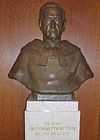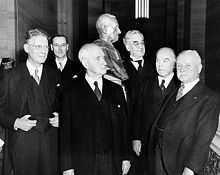Lyman Duff
| The Right Honourable Sir Lyman Duff GCMG, PC, QC | |
|---|---|
 | |
| Lyman Poore Duff in 1910 | |
| 8th Chief Justice of Canada | |
| In office March 17, 1933 – January 7, 1944 | |
| Nominated by | Richard B. Bennett |
| Preceded by | Francis Anglin |
| Succeeded by | Thibaudeau Rinfret |
| 18th Puisne Justice of the Supreme Court of Canada | |
| In office September 27, 1906 – March 17, 1933 | |
| Nominated by | Wilfrid Laurier |
| Preceded by | Robert Sedgewick |
| Succeeded by | Frank Hughes |
| Personal details | |
| Born | Lyman Poore Duff January 7, 1865 Meaford, Ontario |
| Died | April 26, 1955 (aged 90) Ottawa, Ontario |
| Alma mater | University of Toronto |
Sir Lyman Poore Duff, GCMG, PC, QC (7 January 1865 - 26 April 1955) was the eighth Chief Justice of the Supreme Court of Canada, was the longest serving justice of the Supreme Court of Canada,[1] and briefly served as Acting Governor General of Canada in 1931 and 1940.
Born in Meaford, Canada West (now Ontario) to a Congregationalist minister, he received a Bachelor of Arts in mathematics and metaphysics in 1887 and a Bachelor of Laws in 1889 from the University of Toronto. He was called to the Ontario Bar in 1893. In 1901, he was created a Queen's Counsel. From 1890 to 1895, he was a mathematics teacher at Barrie Collegiate Institute. He was a lawyer in Fergus, Ontario and moved to Victoria, British Columbia in 1895 to practise law.
Judicial and other appointments

In 1904, he was appointed a puisne judge of the Supreme Court of British Columbia. In 1906 was appointed a justice of the Supreme Court of Canada. He was appointed Chief Justice of Canada in 1933 and retired in 1944. On January 14, 1914, he was made a member of the Privy Council of the United Kingdom.[2]
In 1931, he served as Administrator of the Government of Canada between the departure of Lord Bessborough for India and the arrival of Lord Tweedsmuir. Duff took on the position, as the Chief Justice was unavailable. In 1933, Duff was promoted to Chief Justice. He was made a Knight Grand Cross of the Order of St. Michael and St. George the following year[3] as a result of Prime Minister Richard Bennett's temporary suspension of the Nickle Resolution.
When Governor General Lord Tweedsmuir died in office on February 11, 1940, according to the rules of succession, Chief Justice Duff became the Administrator of the Government. He held the office for nearly four months, until King George VI appointed a new Governor General on June 21, 1940, acting on the advice of his Canadian Cabinet. Duff was the first Canadian to hold the position, even in the interim. A Canadian Governor General was not appointed until Vincent Massey in 1952.
Impact

Duff employed a conservative form of statutory interpretation. In a 1935 Supreme Court judgment, he detailed how judges should interpret statutes:
The judicial function in considering and applying statutes is one of interpretation and interpretation alone. The duty of the court in every case is loyally to endeavour to ascertain the intention of the legislature; and to ascertain that intention by reading and interpreting the language which the legislature itself has selected for the purpose of expressing it.[4]
Duff has been called a "master of trenchant and incisive English," who "wrote his opinions in a style which bears comparison with Holmes or Birkenhead."[5] A former assistant of Duff, Kenneth Campbell, argued that Duff was "frequently ranked as the equal of Justices Holmes and Brandeis of the United States Supreme Court,"[6] and Gerald Le Dain asserted that Duff "is generally considered to have been one of Canada's greatest judges."[7]
More recent commentary has focused on Duff's legal formalism and its effect on Canadian federalism. Bora Laskin attacked Duff's decisions, arguing that Duff used circular reasoning and hid his policy-laden decisions behind the doctrine of stare decisis.[8] As well, Lionel Schipper noted that, in reviewing Duff's judgments, it was:
apparent that he has given certain factors very little consideration in formulating his decisions. ... In constitutional cases, not only are the actual facts of the case significant but the surrounding social, economic and political facts are equally significant. A shift in these latter factors is as important in deciding a case as any other change in the facts. It is this consideration that Chief Justice Duff ignored.[9]
Further reading
Biography
- W.K. Campbell (1974). "The Right Honourable Sir Lyman Poore Duff, P.C., G.C.M.G.: The Man as I Knew Him". Osgoode Hall Law Journal (Osgoode Hall Law School) 12: 243.
- David Ricardo Williams (1984). Duff: A Life In The Law. Vancouver: University of British Columbia Press. ISBN 0-7748-0203-0.
Constitutional work
- Lionel H. Schipper (1956). "The Influence of Duff C.J.C. on the Trade and Commerce Power". University of Toronto Faculty of Law Review (University of Toronto Faculty of Law) 14: 1.
- Richard Gold (1988). "Sir Lyman Duff and the Fork in the Road". University of Toronto Faculty of Law Review (University of Toronto Faculty of Law) 46: 424.
- Gerald Le Dain (1974). "Sir Lyman Duff and the Constitution". Osgoode Hall Law Journal (Osgoode Hall Law School) 12: 261.
Analysis
- R. Blake Brown (2002). "The Supreme Court of Canada and Judicial Legitimacy: The Rise and Fall of Chief Justice Lyman Poore Duff" (PDF). McGill Law Journal (McGill Law School) 47 (3): 559–591. Retrieved 2012-12-12.
- Richard Gosse (1975). "The Four Courts of Sir Lyman Duff". Canadian Bar Review (Canadian Bar Association) 47 (3): 482.
- Richard Gosse (1975). "Random Thoughts of a Would-Be Judicial Biographer". University of Toronto Law Journal (University of Toronto Press) 19: 597.
- David Ricardo Williams (1984). "The Political Career of Sir Lyman Poore Duff". Supreme Court Law Review (York University) 6: 414.
- David Ricardo Williams (1985). "Begbie & Duff JJ.". The Advocate 43: 749.
Notes
- ↑ DAVID RICARDO WILLIAMS. "Sir Lyman Poore Duff". www.thecanadianencyclopedia.com. Retrieved September 29, 2013.
- ↑ Appointment notice at The London Gazette: no. 31427. p. 1. 1 July 1919. Retrieved 2012-12-13.
- ↑ Appointment notice at The London Gazette: (Supplement) no. 34010. p. 5. 29 December 1933. Retrieved 2009-04-21.
- ↑ The King v. Dubois 1935 CANLII 1 at 381, [1935] SCR 378 (13 May 1935), Supreme Court (Canada)
- ↑ W.H. McConnell (1968). "The Judicial Review of Prime Minister Bennett's 'New Deal". Osgoode Hall Law Journal (Osgoode Hall Law School) 6: 39. at 51
- ↑ Campbell 1974, at 243
- ↑ Le Dain 1974, at 261
- ↑ Bora Laskin (1947). "'Peace, Order and Good Government' Re-Examined". Canadian Bar Review (Canadian Bar Association) 25: 1054. , at 1069-70.
- ↑ Schipper 1956, at 11
References
| Political offices | ||
|---|---|---|
| Preceded by The Lord Tweedsmuir |
Acting Governor General of Canada or administrator 1931 and 1940 |
Succeeded by The Earl of Athlone |
| ||||||||||||||||||
| ||||||||||
| ||||||||||||||||||||||||||||||
| ||||||||||||||||||||||||||||||||||||||
|